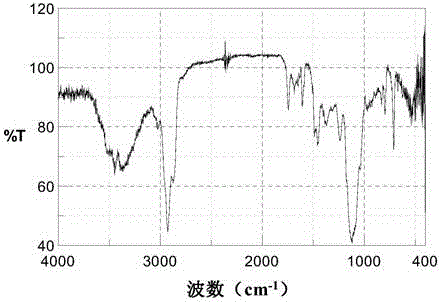Hydrophilic modification method of polystyrene material and product thereof
A polystyrene-based, hydrophilic modification technology, which is applied in the field of polymer material modification, can solve problems such as the difficulty of hydrophilic modification, the difficulty of deep modification and further grafting, and the non-obvious shielding of non-specific adsorption. To achieve the effect of reducing hydrophobicity
- Summary
- Abstract
- Description
- Claims
- Application Information
AI Technical Summary
Problems solved by technology
Method used
Image
Examples
Embodiment 1
[0079] The preparation of embodiment 1 polystyrene (PSt) microspheres
[0080] After mixing 2g of methylstyrene (MST), 2g of styrene, and 1g of divinylbenzene (DVB), add 2g of n-heptane (HP) and 0.3g of benzoyl peroxide (BPO) as pore-forming agents to dissolve as the dispersed phase. Add 2 g of polyvinyl alcohol (PVA) and 0.0015 g of dodecylsulfuric acid (SDS) into 100 mL of deionized water and dissolve it as the continuous phase. Utilize conventional membrane emulsification technology (3.5μm membrane pores) to uniformly disperse the dispersed phase in the continuous phase to form a uniform oil / water emulsion. Then the prepared emulsion was moved into a reactor equipped with a condenser tube, a stirring rod, and a nitrogen conduit, and after replacing oxygen with nitrogen, the microsphere polymerization suspension was obtained after polymerization at 70° C. for 10 h. After the polymerization, the microsphere product was obtained by suction filtration with a Buchner funnel....
Embodiment 2
[0081] The system of embodiment 2 polystyrene (PSt) microspheres prepare
[0082] Weigh 10g of ethylstyrene (EST), 10g of divinylbenzene (DVB), 0.5g of potassium persulfate (KPS) and mix and dissolve it as the oil phase; add 1.9g of PVA, 0.0001g of SDS and 0.0045 g Na 2 SO 4 Completely dissolved as the water phase. Using rapid membrane emulsification technology (2.8 μm membrane pores), the oil-water phase mixture was quickly pressed through the microporous membrane tube and circulated for 4 times to obtain a uniform emulsion. Then the prepared emulsion was moved into a reactor equipped with a condenser tube, a stirring rod, and a nitrogen conduit, and after replacing oxygen with nitrogen, the microsphere polymerization suspension was obtained after a polymerization reaction at 85° C. for 20 h. After the polymerization, centrifuge at 8000rpm with a centrifuge to obtain the microsphere product. After repeated centrifugation and washing with deionized water and ethanol, the...
Embodiment 3
[0083] The preparation of embodiment 3 polystyrene (PSt) microspheres
[0084] Weigh 4.5g styrene (St), 5.5g DVB, 0.28g azoamidine (V65), 3g hexadecane (HD) and 3g n-hexanol (HA) and mix and dissolve them as the oil phase; 3.5g PVA, 0.0008g SDS and 0.009g Na 2 SO 4 Completely dissolved as the water phase. Using conventional membrane emulsification technology (5.2μm membrane pores), the oil phase is uniformly dispersed in the water phase to form a uniform oil / water emulsion. Then the prepared emulsion was moved into a reactor equipped with a condenser tube, a stirring rod, and a nitrogen conduit, and after replacing oxygen with nitrogen, the microsphere polymerization suspension was obtained after a polymerization reaction at 80° C. for 20 h. After the polymerization, the microsphere product was obtained by suction filtration with a Buchner funnel. After repeated washing with deionized water and ethanol, the product is dried in a vacuum oven to obtain highly cross-linked ...
PUM
| Property | Measurement | Unit |
|---|---|---|
| The average particle size | aaaaa | aaaaa |
| Surface aperture | aaaaa | aaaaa |
| Specific surface area | aaaaa | aaaaa |
Abstract
Description
Claims
Application Information
 Login to View More
Login to View More - R&D
- Intellectual Property
- Life Sciences
- Materials
- Tech Scout
- Unparalleled Data Quality
- Higher Quality Content
- 60% Fewer Hallucinations
Browse by: Latest US Patents, China's latest patents, Technical Efficacy Thesaurus, Application Domain, Technology Topic, Popular Technical Reports.
© 2025 PatSnap. All rights reserved.Legal|Privacy policy|Modern Slavery Act Transparency Statement|Sitemap|About US| Contact US: help@patsnap.com



